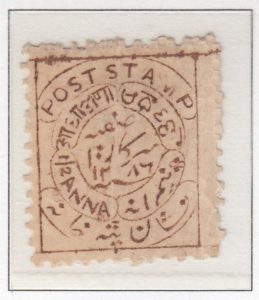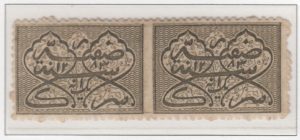
Population: 11,141,142 (in 1901)
Located in the south-central region of India, Hyderabad (also known as Hyderabad Deccan) was the most populous princely state. The capitol Hyderabad City is now temporarily the capitol of two Indian states, Telangana state and Andhra Pradesh, and the former princely state is located in these two states as well as in Maharashtra and Karnataka.
The first stamps of the state were issued in 1849 and 1870 during the reign of Nawab Mir Mahbub Ali Khan Asaf Jah VI who ruled between 1869 and 1911.
The stamps were perforated 11½; issued on white wove paper and gummed. Reprints were made in 1880 in the same colors and in various other colors.
Click here to see all stamps from Hyderabad in this exhibition.
History
Founded by a high-ranking Mughal official who used the weakening of the Mughal empire to seize control of the territory, Hyderabad had become independent by 1724. Muslim rulers oversaw a predominantly Hindu population. As Mughal power gave way to the Maratha Empire, Hyderabad became a tribute state to it. In 1778, British troops were installed in Hyderabad, and it became a protectorate of the British East India Company, with a formal agreement being signed in 1798. Hyderabad sided with the British in the first and second Maratha wars, as well as the Indian Mutiny of 1857. For these services, the Nizam was awarded the title of “Faithful Ally” of the British empire.
Seven different Nizams ruled in the 200 years of the prosperous princely state. They were patrons of the arts and cultivated a Persianate culture. Laws were based upon Islamic Sharia principles. Hyderabad was a rich principality and, in fact, the only supplier of diamonds to the world market in the 18th century. It benefited from reforming and progressive leadership, such as that of Asaf Jah VI. A British Medical Journal article dated 1895 comments, for example,
In the Nizam’s dominion, medical treatment and medical education reached a high standard of excellence. Here was held the famous chloroform commission which was due to the liberality and scientific interest of the Nizam and the energy and enthusiasm of Dr. Lawrie, the presidency surgeon.
In addition, government was reorganized, and charitable, as well as educational institutions were established.
Nizam Mir Usman Ali ruled from 1911-1948, although the British were given powers over possible “misrule.” At one point, he was considered the richest man in the world. The state, with a Hindu majority and 20% Muslim minority, was considered peaceful, if backward, by some, but secular and progressive by others. There is no doubt, however, that improvements were made under this ruler. These included rail travel, roads, waterworks, public buildings, and an Urdu language university. He established a bank and was, in fact, the only ruler in India allowed to issue his own currency.
However, in 1947, upon the establishment of India, the Nizam chose independence, appealing to the British king and the United Nations. This posture ended when Indian troops invaded in “Operation Polo.” The territory of Hyderabad was divided into parts, by language.
The last Nizam’s wealth included a fabulous jewelry collection, which is now housed in Indian vaults. Despite his riches, he lived a humble lifestyle after being deposed. However, with 7 wives and 42 concubines, he had countless descendants, spawning financial claims among India, Pakistan, and many family members. As of 2016, the inheritor of the title is living in Australia, having been married five times, and legal battles continue, now in British courts.
Hyderabad
1869-1871



Imperforate Between